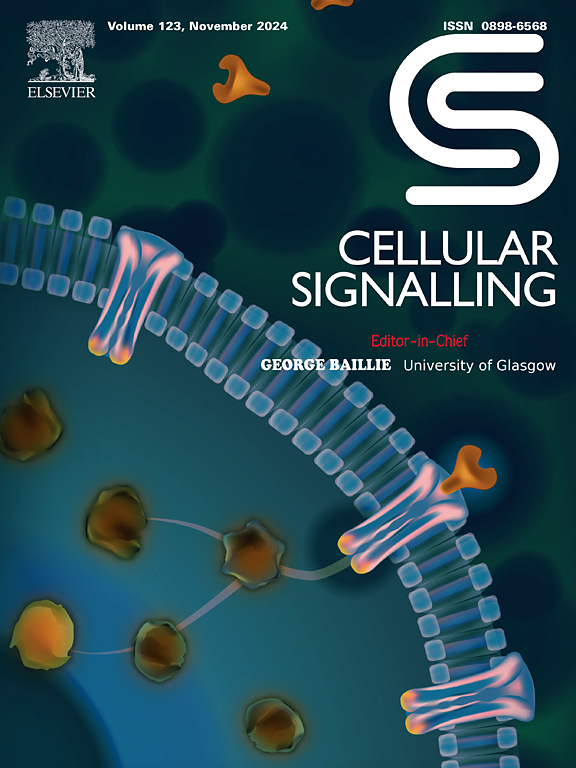富含鞘氨醇-1-磷酸的致癌细胞外小泡在胰腺癌的进展中起着至关重要的作用。
IF 4.4
2区 生物学
Q2 CELL BIOLOGY
引用次数: 0
摘要
来自肿瘤细胞的小细胞外囊泡(sev)介导细胞间通讯和信号传导,调节胰腺导管腺癌(PDAC)的进展。虽然我们和其他人已经证明pdac衍生的sev包含致癌蛋白和核酸货物,但了解这些sev的脂质景观仍然未知。脂质影响sev的组成及其在肿瘤微环境和肿瘤发生中的脂质代谢和信号通路中的作用。我们假设致癌sev中的特定脂质可能为PDAC提供见解。采用液相色谱-电喷雾电离-串联质谱法对PDAC和非恶性胰腺细胞系、患者来源的异种移植细胞系以及PDAC转基因小鼠模型KPC (KRASWT/G12D/ TP53WT/R172H/Pdx1-Cre+/+)血浆中分离的sev进行了基于质谱的综合脂质组学分析。sEV脂质组学分析鉴定了来自25个脂类和亚类的700多种脂质。我们的研究结果表明,与非恶性细胞相比,pdac衍生的sev富含特定的溶血磷脂,特别是鞘氨醇-1-磷酸(S1P),这种脂质在癌症发病中起着关键作用。与WT相比,KPC小鼠血浆源性sev中证实了S1P的富集。为了探索S1P富集的功能意义,我们进行了实验,证明sev中的S1P促进了人微血管内皮细胞的小管形成,并促进了癌症相关成纤维细胞的迁移。我们发现pdac衍生的sev在与癌症表型相关的特定脂质中有差异富集。我们的研究结果强调,pdac衍生的sev富含特定的脂质,特别是S1P,它在促进癌症进展中起着至关重要的作用。本文章由计算机程序翻译,如有差异,请以英文原文为准。
Oncogenic small extracellular vesicles enriched in sphingosine-1-phosphate play a crucial role in pancreatic cancer progression
Small extracellular vesicles (sEVs) from tumour cells mediate intercellular communication and signalling to regulate the progression of pancreatic ductal adenocarcinoma (PDAC). While we and others have shown that PDAC-derived sEVs comprise oncogenic protein and nucleic acid cargo, understanding the lipid landscape of these sEVs remains unknown. Lipids influence both the composition of sEVs and their roles in lipid metabolism and signalling pathways within the tumour microenvironment and tumorigenesis. We hypothesised that specific lipids in oncogenic sEVs might provide insights into PDAC. Comprehensive mass spectrometry-based lipidomic analysis was performed using liquid chromatography-electrospray ionisation-tandem mass spectrometry on sEVs isolated from PDAC and non-malignant pancreatic cell lines, patient-derived xenograft cell lines and plasma from the PDAC transgenic mouse model KPC (KRASWT/G12D/ TP53WT/R172H/Pdx1-Cre+/+). The sEV lipidomic analyses identified over 700 lipid species from 25 lipid classes and subclasses. Our results showed that, compared to non-malignant cells, PDAC-derived sEVs were enriched in specific lysophospholipids, particularly sphingosine-1-phosphate (S1P), a lipid known for its pivotal role in cancer pathogenesis. S1P enrichment was validated in plasma-derived sEVs from KPC mice compared to WT. To explore the functional implications of S1P enrichment, we conducted assays demonstrating that S1P in sEVs facilitated tubule formation in human microvascular endothelial cells and promoted cancer-associated fibroblast cell migration. We show that PDAC-derived sEVs are differentially enriched in specific lipids associated with cancer phenotype. Our findings highlight that PDAC-derived sEVs are enriched in specific lipids, particularly S1P, which plays a crucial role in promoting cancer progression.
求助全文
通过发布文献求助,成功后即可免费获取论文全文。
去求助
来源期刊

Cellular signalling
生物-细胞生物学
CiteScore
8.40
自引率
0.00%
发文量
250
审稿时长
27 days
期刊介绍:
Cellular Signalling publishes original research describing fundamental and clinical findings on the mechanisms, actions and structural components of cellular signalling systems in vitro and in vivo.
Cellular Signalling aims at full length research papers defining signalling systems ranging from microorganisms to cells, tissues and higher organisms.
 求助内容:
求助内容: 应助结果提醒方式:
应助结果提醒方式:


